Parasitic Loop Inductances Reduction in the PCB Layout in GaN-Based Power Converters Using S-Parameters and EM Simulations
Abstract
1. Introduction
2. Commutation Loop Characterization Method
2.1. Description of the Studied Commutation Loop
2.2. Calibration Procedure
2.3. S-Parameter Measurement Techniques
3. Characterization and Modeling of a Lateral Commutation Loop Inductance
3.1. Inductance of a Lateral PCB Loop
3.2. GaN Transistors Drain–Source Inductance
3.3. Inductance of a Lateral Commutation Loop Including GaN Devices
4. Characterization and Modeling of a Vertical Commutation Loop Inductance
4.1. Inductance of a Vertical PCB Loop
4.2. Inductance of a Vertical Commutation Loop Including GaN Transistors
5. Analysis of GaN Transistors Switching Waveforms for Two Commutation Loops
6. Discussion
Author Contributions
Funding
Acknowledgments
Conflicts of Interest
References
- Omura, I.; Saito, W.; Domon, T.; Tsuda, K. Gallium Nitride power HEMT for high switching frequency power electronics. In Proceedings of the 2007 International Workshop on Physics of Semiconductor Devices, Mumbai, India, 16–20 December 2007. [Google Scholar]
- Reusch, D.; Strydom, J.; Lidow, A. A new family of GaN transistors for highly efficient high frequency DC-DC converters. In Proceedings of the 2015 IEEE Applied Power Electronics Conference and Exposition (APEC), Charlotte, NC, USA, 15–19 March 2015. [Google Scholar]
- Maset, E.; Ejea, J.B.; Ferreres, A.; Lizán, J.L.; Blanes, J.M.; Sanchis-Kilders, E.; Garrigós, A. Optimized Design of 1 MHz Intermediate Bus Converter Using GaN HEMT for Aerospace Applications. Energies 2020, 13, 6583. [Google Scholar] [CrossRef]
- Faraci, E.; Seeman, M.; Gu, B.; Ramadass, Y.; Brohlin, P. High Efficiency and Power Density GaN-Based LED Driver. In Proceedings of the 2016 IEEE Applied Power Electronics Conference and Exposition (APEC), Long Beach, CA, USA, 20–24 March 2016. [Google Scholar]
- Ahmed, M.H.; De Rooij, M.A.; Wang, J. High-Power Density, 900-W LLC Converters for Servers Using GaN FETs: Toward Greater Efficiency and Power Density in 48 V to 6\/12 V Converters. IEEE Power Electron. Mag. 2019, 6, 40–47. [Google Scholar] [CrossRef]
- Salomez, F.; Vienot, S.; Zaidi, B.; Videt, A.; Duquesne, T.; Pichon, H.; Semail, E.; Idir, N. Design of an integrated GaN inverter into a multiphase PMSM. In Proceedings of the 2020 IEEE Vehicle Power and Propulsion Conference (VPPC), Gijon, Spain, 26–29 October 2020. [Google Scholar]
- Vienot, S.; Videt, A.; Idir, N.; Kone, L.; Weiss, S.; Lafon, F. Frequency-domain simulation of power electronic systems based on multi-topology equivalent sources modelling method. In Proceedings of the 2020 22nd European Conference on Power Electronics and Applications (EPE’20 ECCE Europe), Lyon, France, 7–11 September 2020. [Google Scholar]
- Lu, S.; Zhao, T.; Burgos, R.P.; Lu, G.; Bala, S.; Xu, J. PCB-Interposer-on-DBC Packaging of 650 V, 120 A GaN HEMTs. In Proceedings of the 2020 IEEE Applied Power Electronics Conference and Exposition (APEC), New Orleans, LA, USA, 15–19 March 2020. [Google Scholar]
- Longford, A.; Klowak, G. Utilising advanced packaging technologies to enable smaller, more efficient GaN power devices. In Proceedings of the 2013 Eurpoean Microelectronics Packaging Conference (EMPC), Grenoble, France, 9–12 September 2013. [Google Scholar]
- Sun, R.; Lai, J.; Chen, W.; Zhang, B. GaN Power Integration for High Frequency and High Efficiency Power Applications: A Review. IEEE Access 2020, 8, 15529–15542. [Google Scholar] [CrossRef]
- Moench, S.; Costa, M.; Barner, A.; Kallfass, I.; Reiner, R.; Weiss, B.; Waltereit, P.; Quay, R.; Ambacher, O. Monolithic integrated quasi-normally-off gate driver and 600 V GaN-on-Si HEMT. In Proceedings of the 2015 IEEE 3rd Workshop on Wide Bandgap Power Devices and Applications (WiPDA), Blacksburg, VA, USA, 2–4 November 2015. [Google Scholar]
- Zhang, Y.; Rodríguez, M.; Maksimović, D. Very High Frequency PWM Buck Converters Using Monolithic GaN Half-Bridge Power Stages With Integrated Gate Drivers. IEEE Trans. Power Electron. 2015, 31, 7926–7942. [Google Scholar] [CrossRef]
- Lai, L.; Zhang, R.; Cheng, K.; Xia, Z.; Wei, C.; Wei, K.; Luo, W.; Liu, X. Monolithic Integrated High Frequency GaN DC-DC Buck Converters with High Power Density Controlled by Current Mode Logic Level Signal. Electronics 2020, 9, 1540. [Google Scholar] [CrossRef]
- Reusch, D.; Strydom, J. Understanding the Effect of PCB Layout on Circuit Performance in a High-Frequency Gallium-Nitride-Based Point of Load Converter. IEEE Trans. Power Electron. 2013, 29, 2008–2015. [Google Scholar] [CrossRef]
- Wang, K.; Wang, L.; Yang, X.; Zeng, X.; Chen, W.; Li, H. A Multiloop Method for Minimization of Parasitic Inductance in GaN-Based High-Frequency DC–DC Converter. IEEE Trans. Power Electron. 2016, 32, 4728–4740. [Google Scholar] [CrossRef]
- Sun, B.; Zhang, Z.; Andersen, M.A. Research of PCB Parasitic Inductance in the GaN Transistor Power Loop. In Proceedings of the 2019 IEEE Workshop on Wide Bandgap Power Devices and Applications in Asia (WiPDA Asia), Taipei, Taiwan, 23–25 May 2019. [Google Scholar]
- Letellier, A.; Dubois, M.R.; Trovao, J.P.F.; Maher, H. Calculation of Printed Circuit Board Power-Loop Stray Inductance in GaN or High di/dt Applications. IEEE Trans. Power Electron. 2018, 34, 612–623. [Google Scholar] [CrossRef]
- Cao, Y.S.; Makharashvili, T.; Cho, J.; Bai, S.; Connor, S.; Archambeault, B.; Jiang, L.; Ruehli, A.E.; Fan, J.; Drewniak, J.L. Inductance Extraction for PCB Prelayout Power Integrity Using PMSR Method. IEEE Trans. Electromagn. Compat. 2017, 59, 1339–1346. [Google Scholar] [CrossRef]
- Aberg, B.; Moorthy, R.S.K.; Yang, L.; Yu, W.; Husain, I. Estimation and minimization of power loop inductance in 135 kW SiC traction inverter. In Proceedings of the 2018 IEEE Applied Power Electronics Conference and Exposition (APEC), San Antonio, TX, USA, 4–8 March 2018. [Google Scholar]
- Pace, L.; Defrance, N.; Videt, A.; Idir, N.; De Jaeger, J.-C.; Avramovic, V. Extraction of Packaged GaN Power Transistors Parasitics Using S-Parameters. IEEE Trans. Electron Devices 2019, 66, 2583–2588. [Google Scholar] [CrossRef]
- Liu, T.; Wong, T.T.Y.; Shen, Z.J. A New Characterization Technique for Extracting Parasitic Inductances of SiC Power MOSFETs in Discrete and Module Packages Based on Two-Port S-Parameters Measurement. IEEE Trans. Power Electron. 2018, 33, 9819–9833. [Google Scholar] [CrossRef]
- Li, K.; Videt, A.; Idir, N. Multiprobe Measurement Method for Voltage-Dependent Capacitances of Power Semiconductor Devices in High Voltage. IEEE Trans. Power Electron. 2013, 28, 5414–5422. [Google Scholar] [CrossRef]
- Chafi, A.; Idir, N.; Videt, A.; Maher, H. Design Method of PCB Inductors for High-Frequency GaN Converters. IEEE Trans. Power Electron. 2020, 36, 805–814. [Google Scholar] [CrossRef]
- Yang, S.-S.; Soh, J.-H.; Kim, R.-Y. Parasitic Inductance Reduction Design Method of Vertical Lattice Loop Structure for Stable Driving of GaN HEMT. In Proceedings of the 2019 IEEE 4th International Future Energy Electronics Conference (IFEEC), Singapore, 25–28 November 2019. [Google Scholar]
- Kaupp, H.R. Characteristics of Microstrip Transmission Lines. IEEE Trans. Electron. Comput. 1967, EC-16, 185–193. [Google Scholar] [CrossRef]
- Hirano, T.; Hirokawa, J.; Ando, M. Influence of the SMA connector and its modeling on electromagnetic simulation. Microw. Opt. Technol. Lett. 2015, 57, 2168–2171. [Google Scholar] [CrossRef]
- Palecek, J.; Vestenicky, M.; Vestenicky, P.; Spalek, J. Examination of SMA connector parameters. In Proceedings of the 2012 IEEE 16th International Conference on Intelligent Engineering Systems (INES), Lisbon, Portugal, 13–15 June 2012. [Google Scholar]
- Stepins, D.; Asmanis, G.; Asmanis, A. Measuring Capacitor Parameters Using Vector Network Analyzers. Electron. ETF 2014, 18, 29–38. [Google Scholar] [CrossRef]
- Walker, B. Make Accurate Impedance Measurements Using a VNA. Microw. RF 2019, 30–36. [Google Scholar]
- Dambrine, G.; Cappy, A.; Heliodore, F.; Playez, E. A new method for determining the FET small-signal equivalent circuit. IEEE Trans. Microw. Theory Tech. 1988, 36, 1151–1159. [Google Scholar] [CrossRef]
- Paul, C.R. Inductance: Loop and Partial; Wiley-IEEE Press: Piscataway, NJ, USA, 2011. [Google Scholar]
- Masuda, T.; Shiramizu, N.; Nakamura, T.; Washio, K. Characterization and Modeling of Microstrip Transmission Lines with Slow-Wave Effect. In Proceedings of the 2008 IEEE Topical Meeting on Silicon Monolithic Integrated Circuits in RF Systems, Orlando, FL, USA, 23–25 January 2008. [Google Scholar]
- Prasobhu, P.K.; Hoffmann, F.; Liserre, M. Transient-Immune GaN Gate Driver and Power Layout. In Proceedings of the 2019 IEEE Applied Power Electronics Conference and Exposition (APEC), Anaheim, CA, USA, 27 May 2019. [Google Scholar]
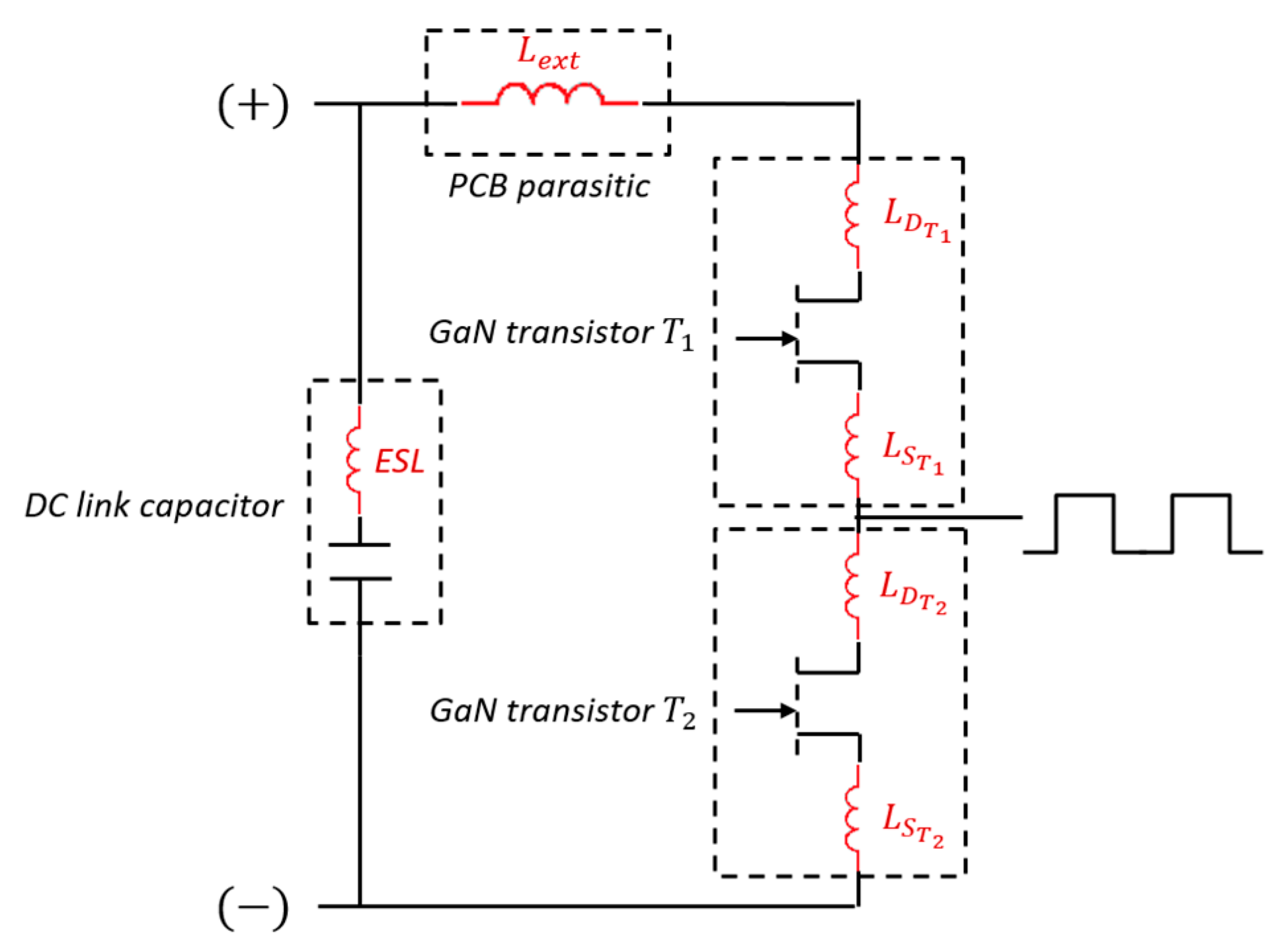
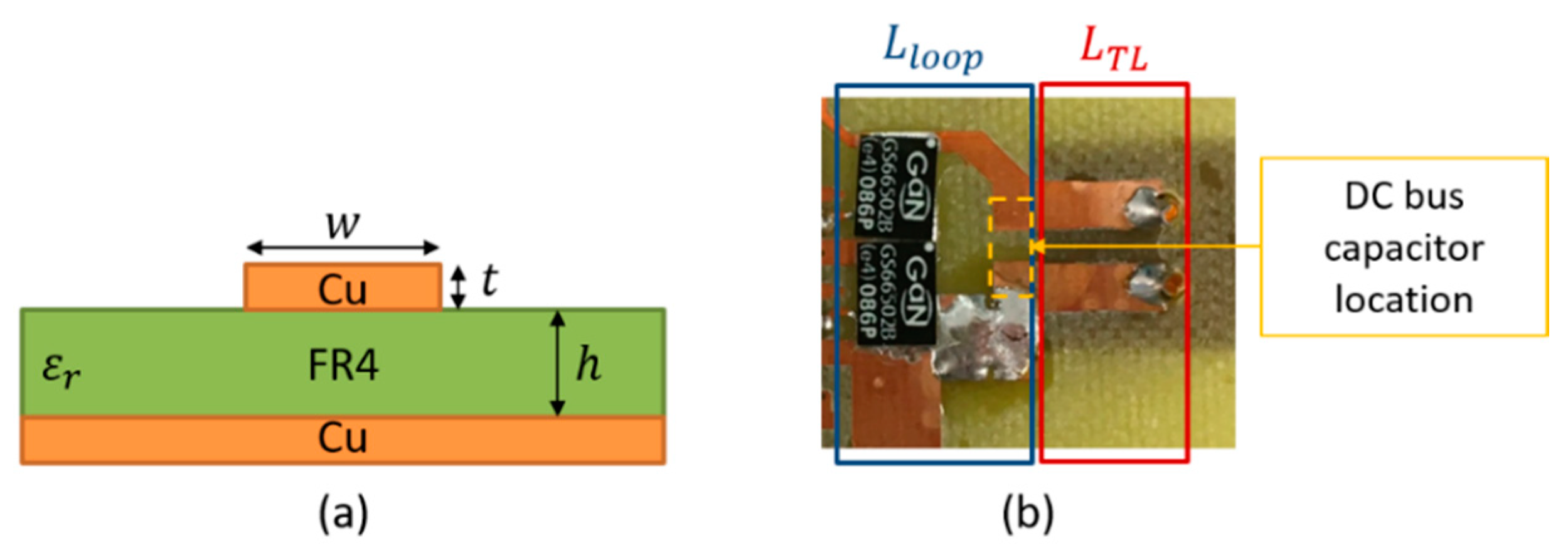

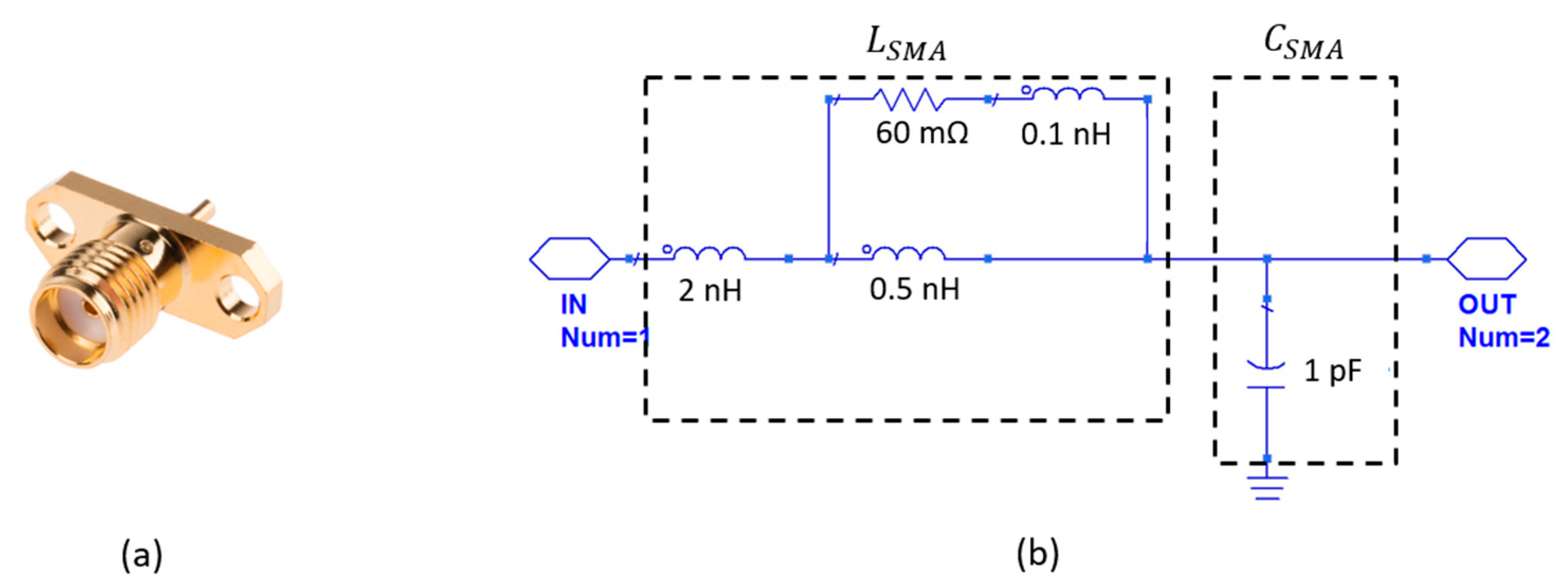




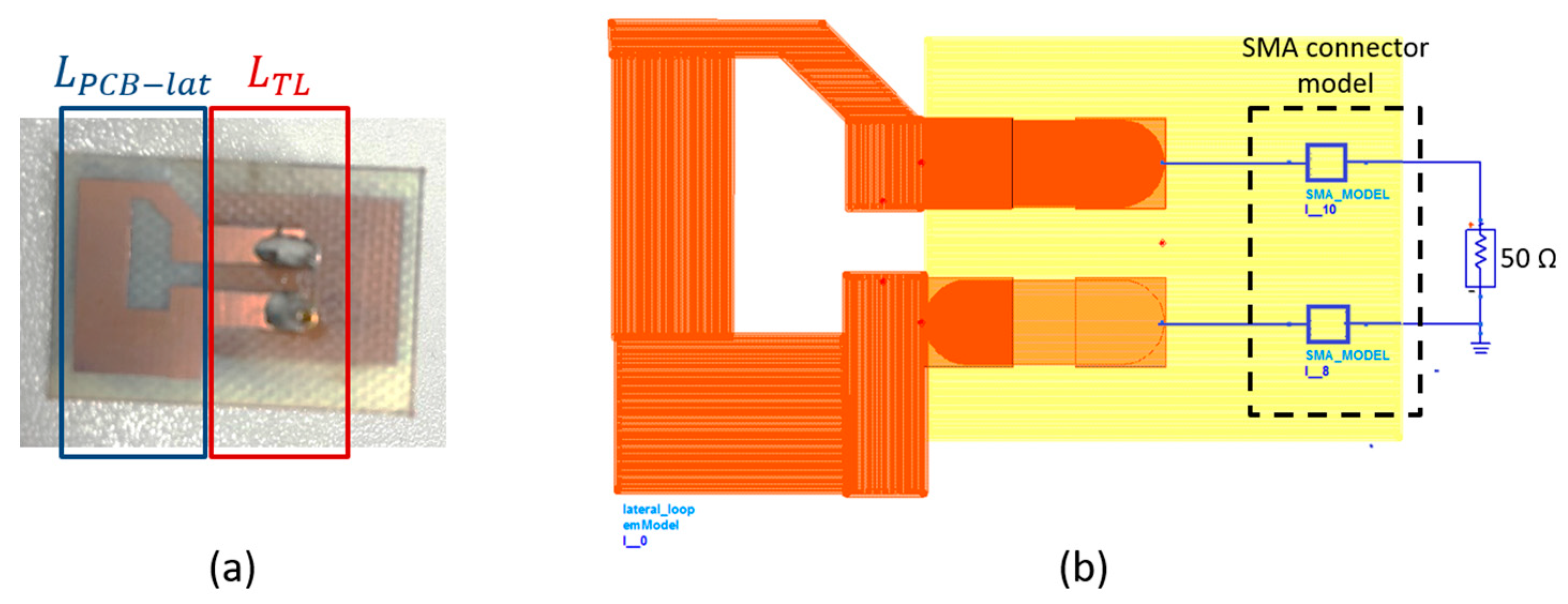
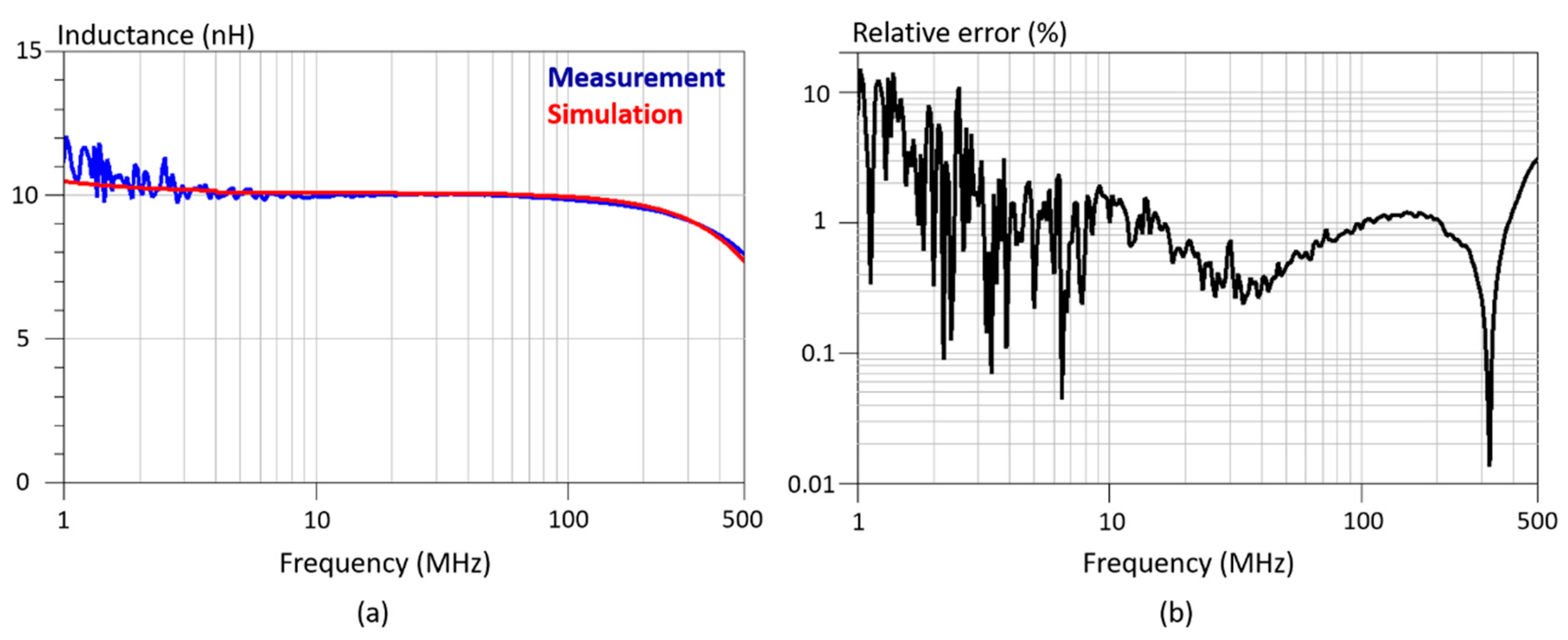

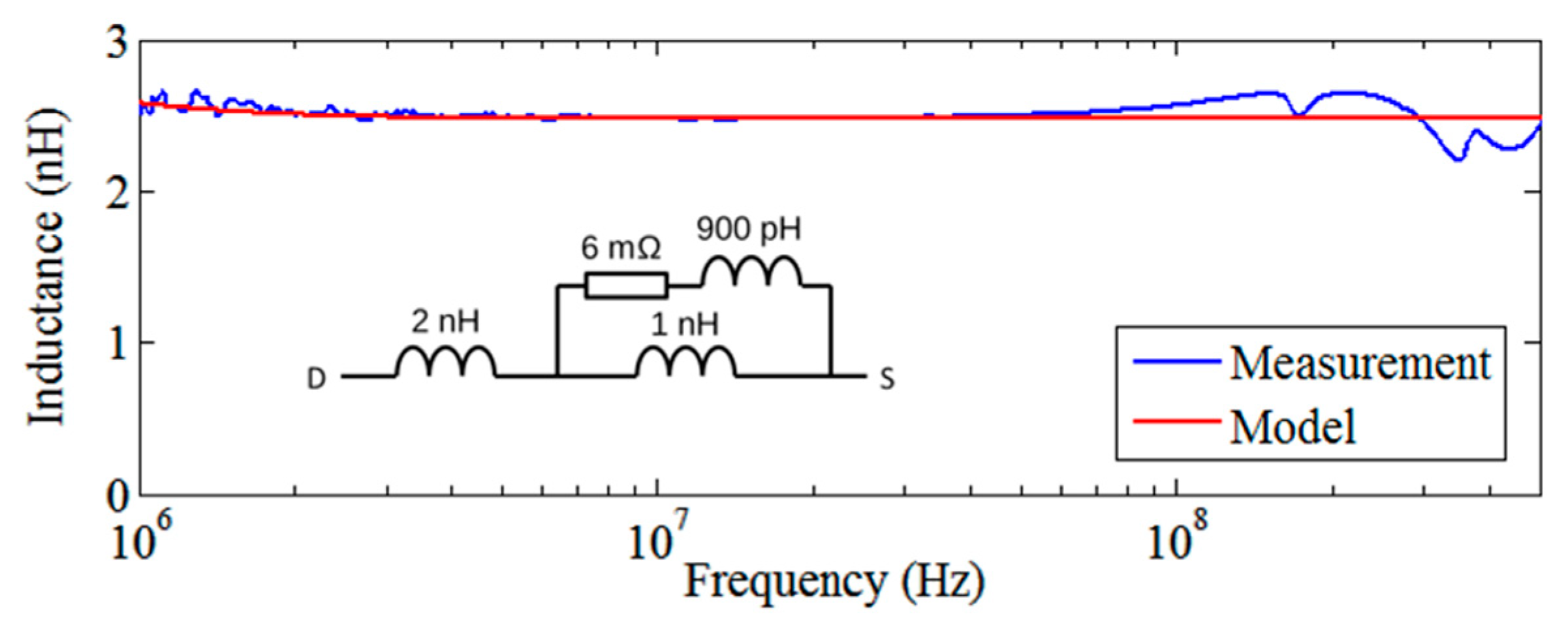
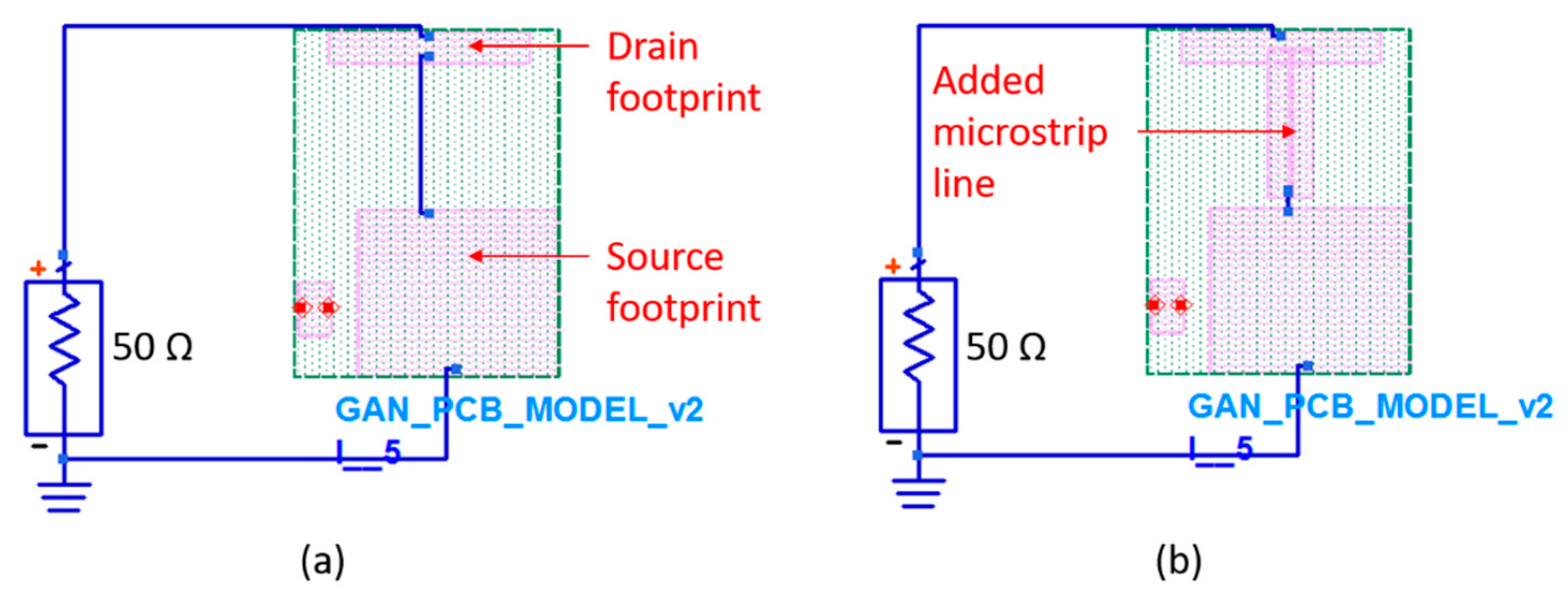

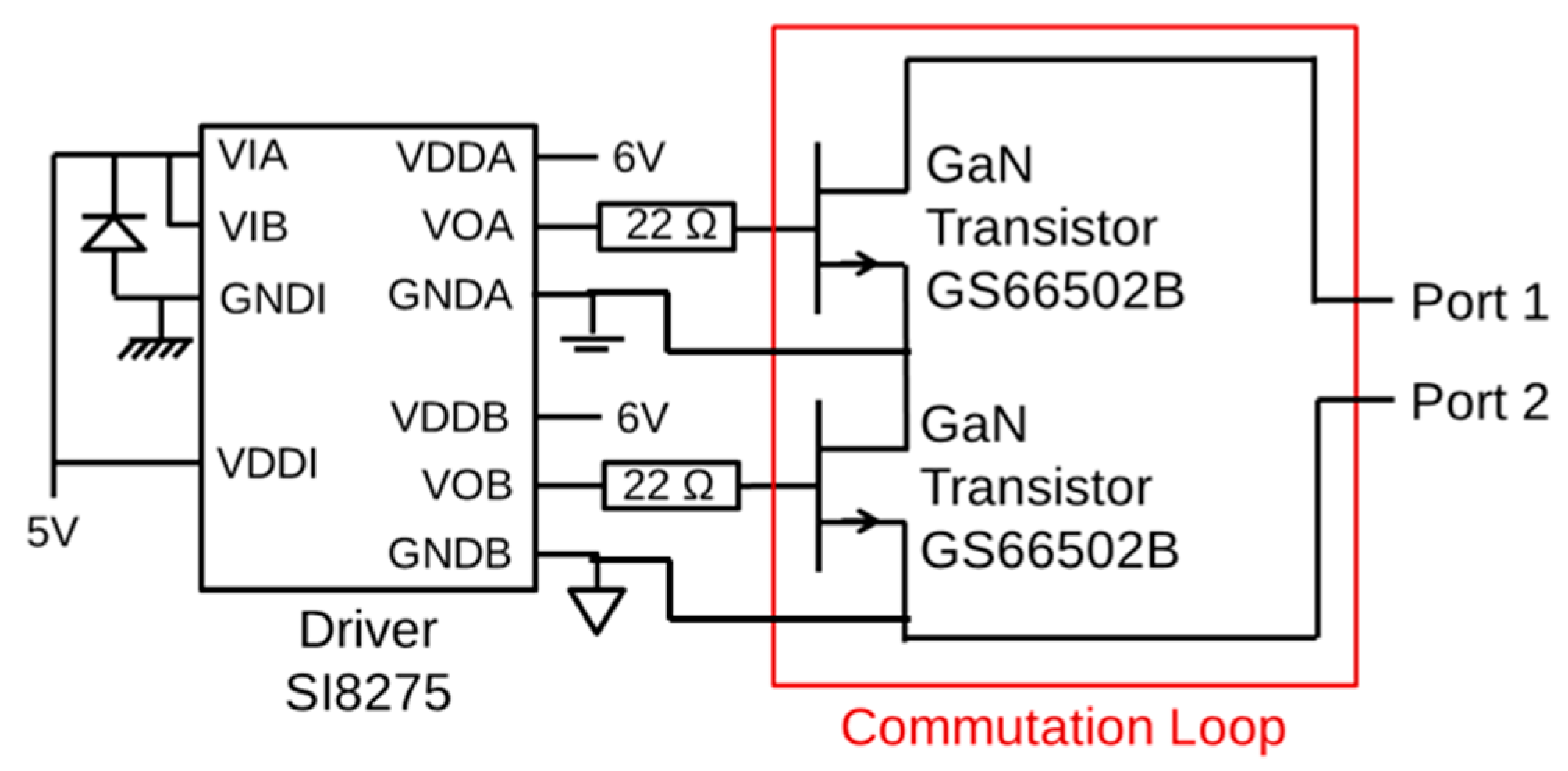





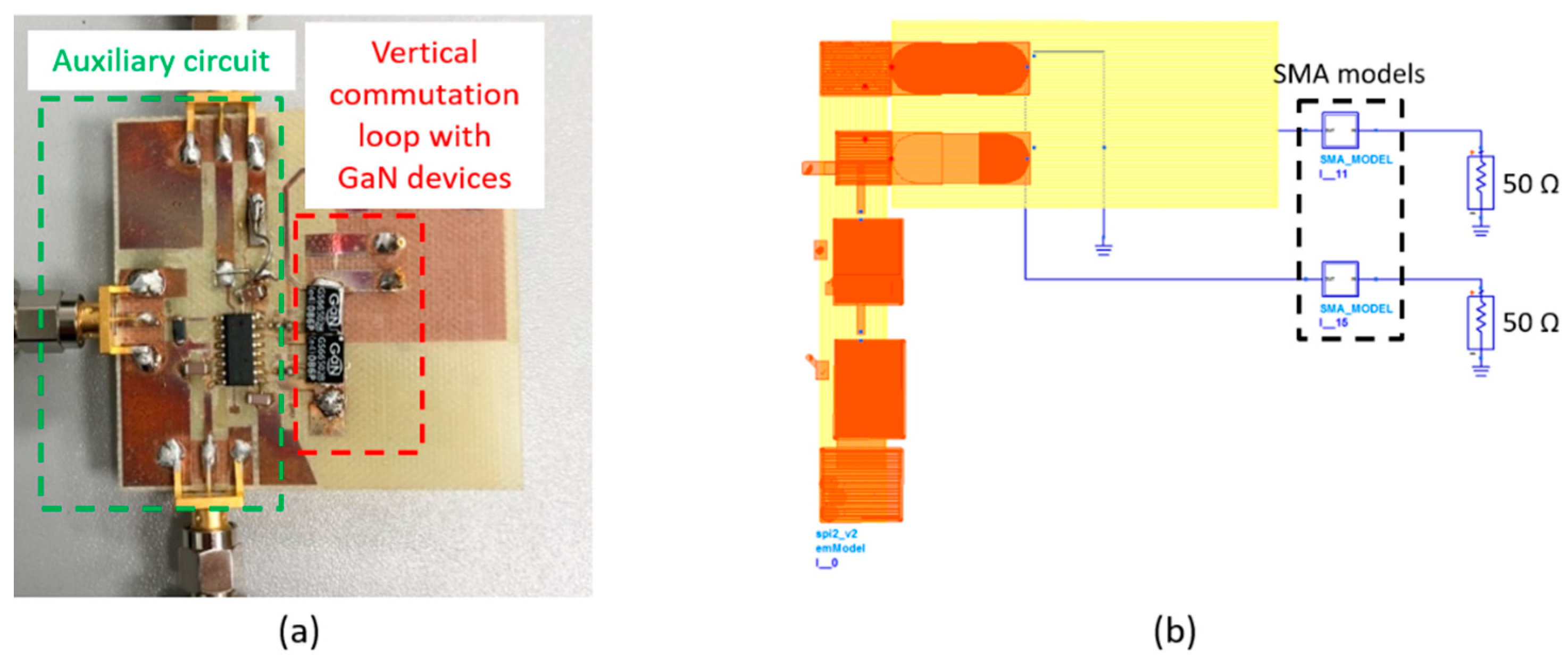



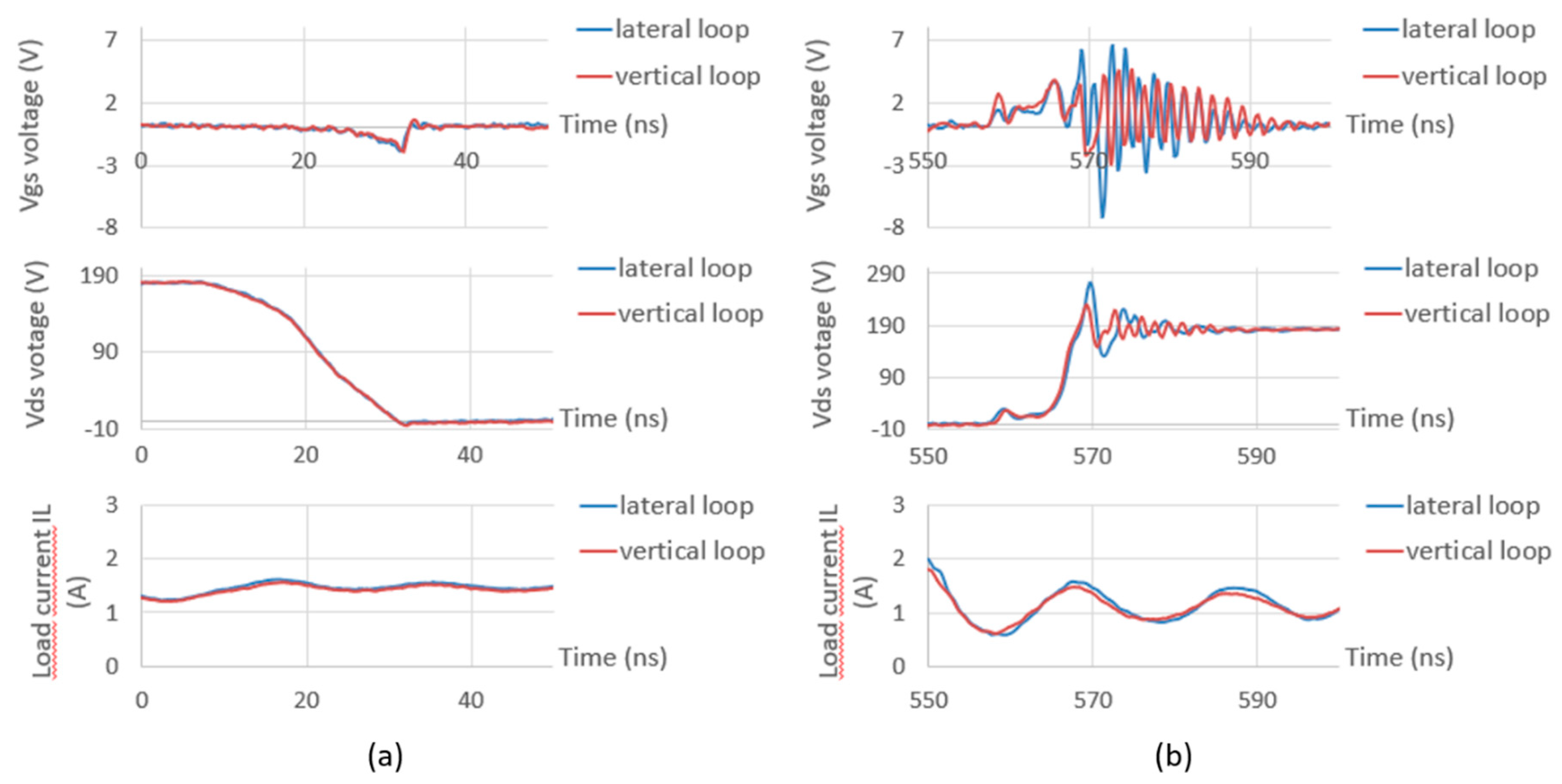

| S-Parameters Reference | Frequency Plan | Mesh |
|---|---|---|
| Bottom layer (ground plane) | 1–2 GHz (adaptive) | 50 cells per wavelength |
| 10 MHz | 100 MHz | |||||
|---|---|---|---|---|---|---|
| Measurement | 12.35 | 4.85 | 0.39 | 12.19 | 4.70 | 0.39 |
| Simulation | 12.52 | 3.94 | 0.32 | 12.36 | 3.80 | 0.31 |
Publisher’s Note: MDPI stays neutral with regard to jurisdictional claims in published maps and institutional affiliations. |
© 2021 by the authors. Licensee MDPI, Basel, Switzerland. This article is an open access article distributed under the terms and conditions of the Creative Commons Attribution (CC BY) license (http://creativecommons.org/licenses/by/4.0/).
Share and Cite
Pace, L.; Idir, N.; Duquesne, T.; De Jaeger, J.-C. Parasitic Loop Inductances Reduction in the PCB Layout in GaN-Based Power Converters Using S-Parameters and EM Simulations. Energies 2021, 14, 1495. https://doi.org/10.3390/en14051495
Pace L, Idir N, Duquesne T, De Jaeger J-C. Parasitic Loop Inductances Reduction in the PCB Layout in GaN-Based Power Converters Using S-Parameters and EM Simulations. Energies. 2021; 14(5):1495. https://doi.org/10.3390/en14051495
Chicago/Turabian StylePace, Loris, Nadir Idir, Thierry Duquesne, and Jean-Claude De Jaeger. 2021. "Parasitic Loop Inductances Reduction in the PCB Layout in GaN-Based Power Converters Using S-Parameters and EM Simulations" Energies 14, no. 5: 1495. https://doi.org/10.3390/en14051495
APA StylePace, L., Idir, N., Duquesne, T., & De Jaeger, J.-C. (2021). Parasitic Loop Inductances Reduction in the PCB Layout in GaN-Based Power Converters Using S-Parameters and EM Simulations. Energies, 14(5), 1495. https://doi.org/10.3390/en14051495







